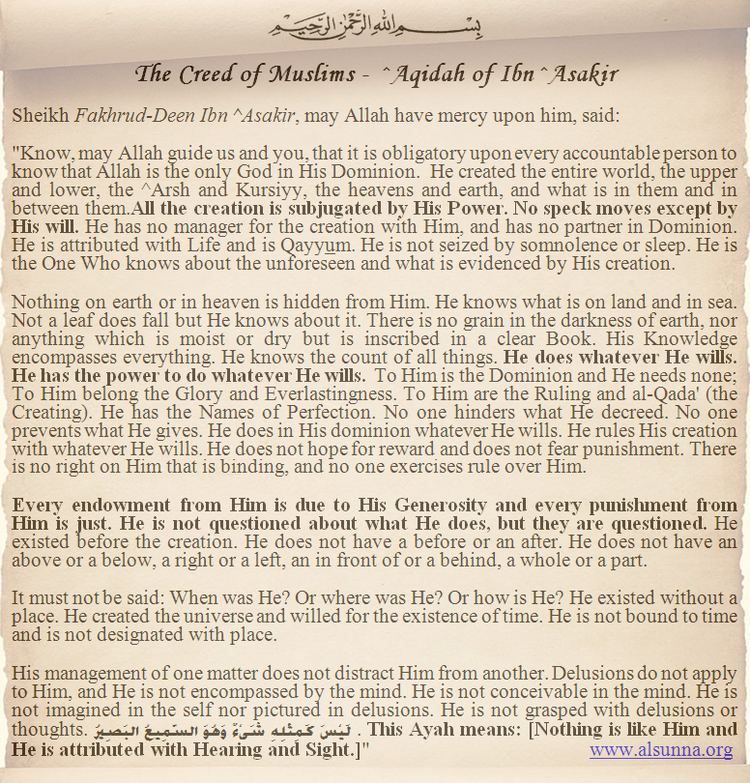Era Medieval era Creed Ash'ari Died 1175, Damascus, Syria Jurisprudence Shafi'i Role Islamic scholar | Denomination Sunni Name Ibn 'Asakir Religion Islam Main interest(s) History Region Damascus | |
 | ||
Parents Abi Mohamed al-Hasan ibn Hibat Allah ibn `Abd Allah | ||
Aqidah creed of ibn asakir
Ibn Asakir (Arabic: ابن عساكر, Ibn ‘Asākir; 1106–1175) was a Sunni Islamic scholar, a historian and a student of the Sunni mystic Abu al-Najib Suhrawardi.
Contents
Name
His full name was Ali ibn al-Hasan ibn Hibat Allah ibn `Abd Allah, Thiqat al-Din, Abu al-Qasim, known as Ibn `Asakir al-Dimashqi al-Shafi`i al-Ash`ari (الحافظ المورخ علی بن الحسن بن ھبۃ اللہ بن عبداللہ بن الحسین الدمشقی الشافعی).
Life
Born in Damascus, during the reign of atabeg Toghtekin, Ibn Asakir received an extensive education, as befitting someone from a wealthy family. By 1120, he was attending lectures of al-Sulami at the Shafi'i madrasa, which was built by atabeg Gumushtegin. He traveled to Baghdad, following the death of his father, and went on hajj in 1127. He returned to Baghdad to hear lectures at the Nezamiyeh, from Abu l'Hasan al-Ansari(a pupil of al-Ghazali), lectures on the hadith of Abi Salih al-Karamani and Ibn al-Husayn Abu 'l-Kasim.
By 1132, Ibn Asakir returned to Damascus being married within the year. Civil disturbances forced him to leave Damascus and travel from Isafahan to Merv, where he met Abu Sa'd 'Abd al-Karim al-Samani. With al-Samani he travel to Nishapur and Herat and by 1139 he had passed through Baghdad on his way back to Damascus. Throughout his journey he collected numerous hadiths and had become a hafiz.
Under the patronage of Nur ad-Din Zangi, Ibn Asakir wrote the Tarikh Dimashq. In 1170, Nur al-Din built the madrasa Dar al-Hadith for Ibn Asakir.
Ibn Asakir studied under 80 female Muslim scholars.
Works
"Likewise, The Najjariyya held that the Creator is in every place without localization or direction. And the Hashwiyya and Mujassima held that God is localized on the Throne, and that Throne is a place for him, and that He is sitting on it. But al-Ash'ari followed a middle course between them and held that God was when no place was, and then He created the Throne and the [Kursiyy] without His needing a place, and He was just the same after creating place as He had been before He created it."
